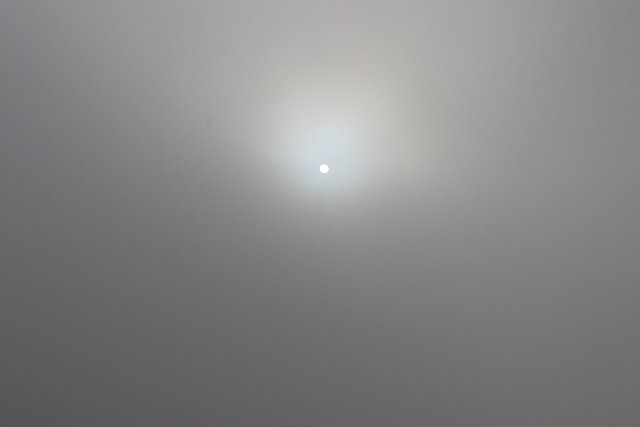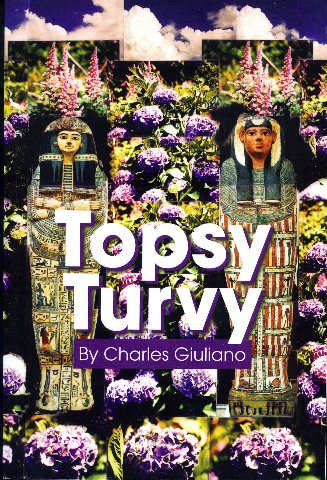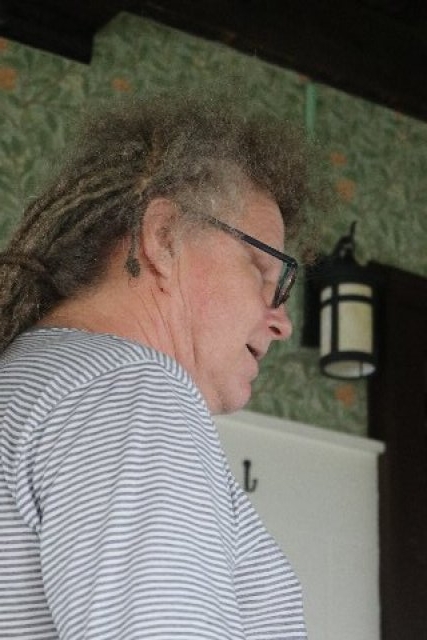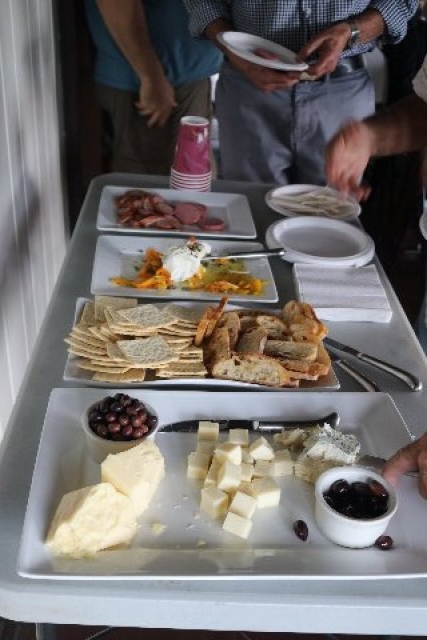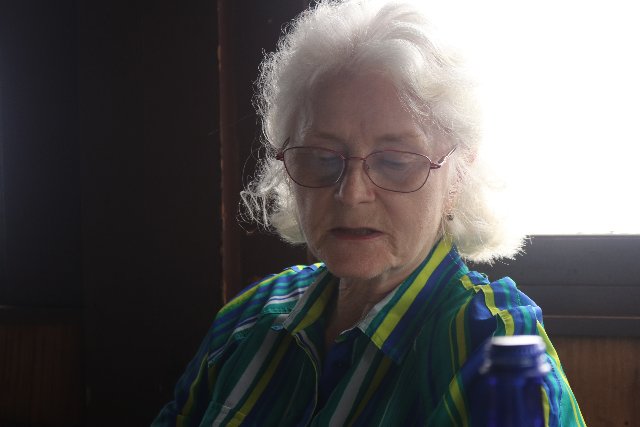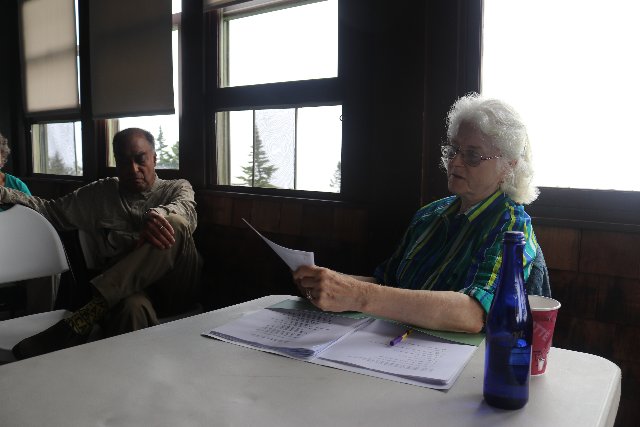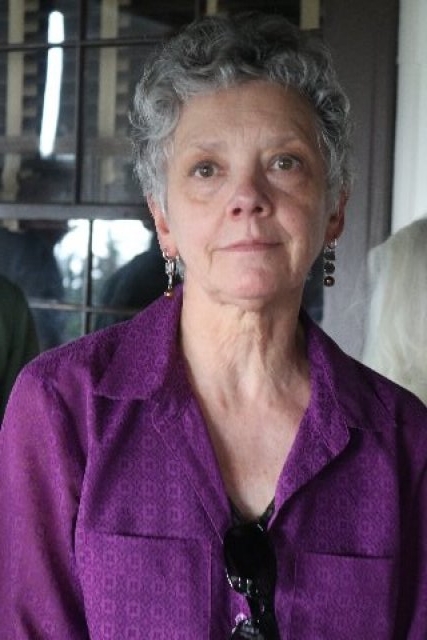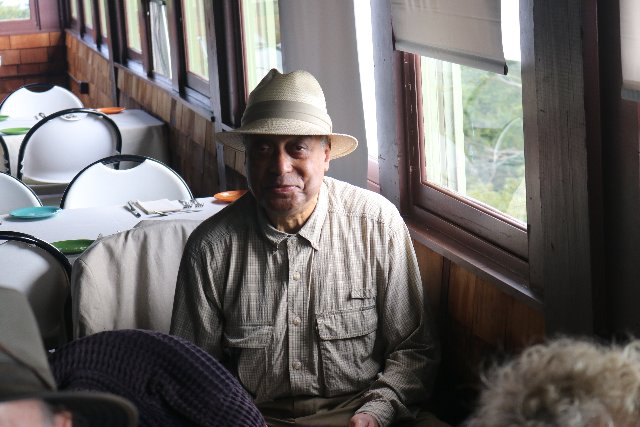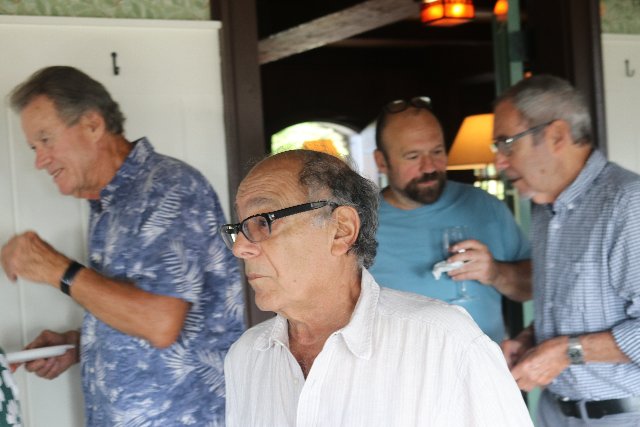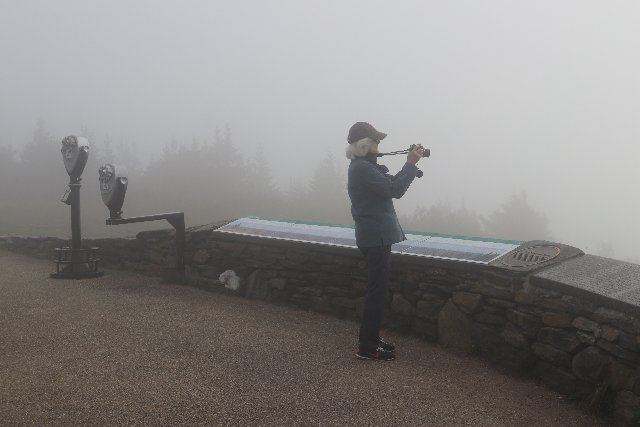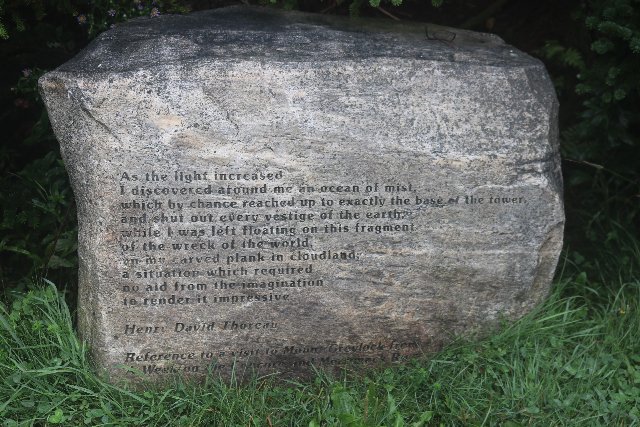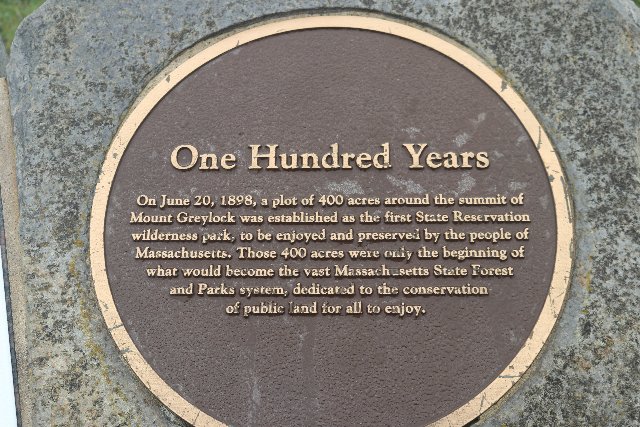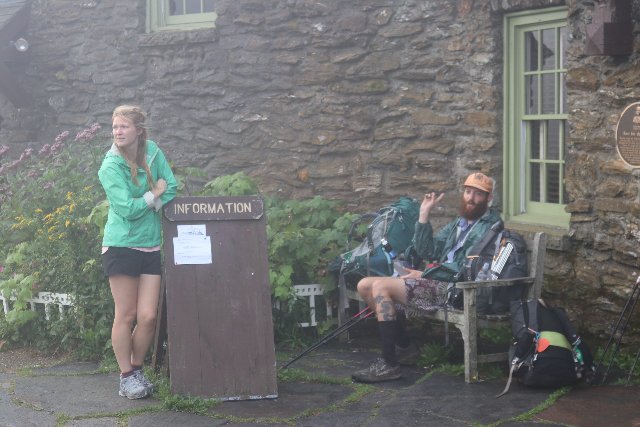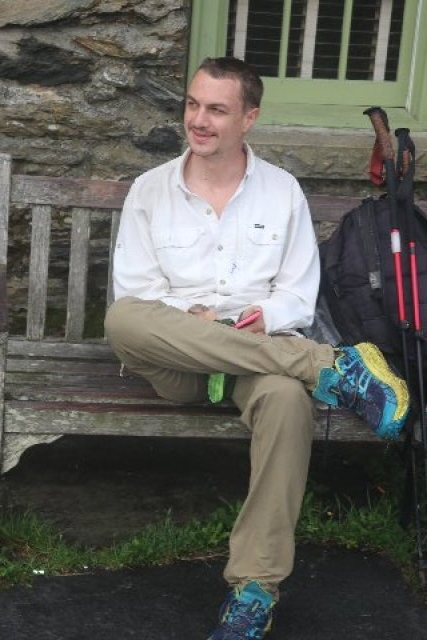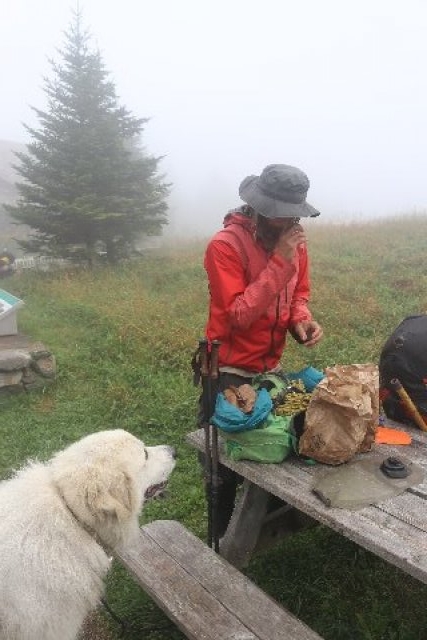Topsy Turvy on Mt. Greylock
Bascom Lodge Reading and Book Launch
By: Charles Giuliano - Sep 04, 2018
It’s a long and winding road to reach the summit of Mt. Greylock and its historic Bascom Lodge.
After a busy summer of covering the arts in the Berkshires, there was a special event to bookend the season. On Sunday of Labor Day weekend, Astrid Hiemer and I shared a reading and launch of my fifth book of gonzo verse Topsy Turvy. The event reflected our ongoing collaborations. She contributed 19 photo illustrations for the book.
Arriving at 3 PM we registered and got settled in a spacious end room. From the windows we could see visitors including guests that arrived for the 5 PM event. There was a great stone hearth that, on this occasion, was not needed. The season of Bascom Lodge ends on October 21.
Special events, a couple per week in season, are curated by the artist, Peter Dudek, who hosted and introduced us. His brother John is the chef who prepared the three course, prix fixe meal we enjoyed accompanied by a jazz concert. The Lodge serves three meals each day.
It was wonderful to see 30 plus of our friends and strangers on the porch. There was a nice spread of toasted bread, crackers, salami and different kinds of cheese.
The guests enjoyed the snacks and settled in as Peter discussed the colorful history of the Lodge.
During the Depression era of the 1930s the Lodge, road, and trails were developed by the Civil Conservation Corps (CCC). It was a government program to put young men to work and train them in useful skills for later employment.
We were surprised to learn that they lived and worked on the mountain with room and board. The salary was $5 a week of which they were mandated to send home a dollar. Living in a camp setting there wasn’t much to spend it on. There was a good laugh when Peter told us that, now and then, ladies came for dances. One may just imagine what that was like.
Today, there is a well paved road to the summit. Back in the 1930s, when under construction, it was more challenging to bring up supplies. We learned that most of the timber and stone used for construction came from the area around the summit. Even much of the hardware was forged on site.
The readings began with Astrid. She was well prepared with a folder of printed out poems some of which had previously been posted to Berkshire Fine Arts. The first was Venus of Willendorf which was inspired by the tiny, 25,000-year-old, female nude which we viewed during a visit to Wien some time ago. Hearing it again was emotional for both of us.
There were amused responses to Nutmeg and Mace as well a recount of her first car accident in some 50 years The Dental Debacle. It occurred following a long dental visit.
During our weekly visits to Jacob’s Pillow this summer she created a series of poetic responses. She read one of these based on a performance of the Dorrance Dance company.
She ended with the award winning Paternoster. It was one of 33 submissions to the Berkshire Fine Arts Elevator Poem Contest. It resulted from my friend Jonas Doyvedenas, commenting on the range of subjects in my writing. He stated that “You can’t write a poem about an elevator.” We accepted that as a challenge.
What resulted was quite wonderful. The contest was judged by writer and scholar, Mark Miller, the former chair of the English Department of MCLA. First prize went to Gail Burns, second to Astrid, and Stephen Rifkin took the bronze.
Her poem is based on unique, antique European elevators which run continuously. Riders can hop on and off as there is no door. As kids Astrid and her brother Arno liked to play on them. She read the poem first in English and then in German.
My part of the program started in response to interaction earlier in the week with Wilma Rifkin. She asked for the title of the new book and then what it meant? This time, she asked, would I actually read the poems?
Based on past “readings” she was commenting on how often they are more like conceptual performance art and standup comedy. This time there was some of that, but in deference to Wilma, I tried to do more actual reading.
That started with Topsy Turvy which I hoped set the mood for the current work. Then the last was first as I recited the most recent work Foucault You Man. It was preceded by a discussion of Alterstil in the arts, generally what occurs in the work of senior artists. There was discussion of what happens in a fresco cycle as, for example, Giotto’s Arena Chapel in Padua, or Michelangelo’s Sistine Chapel. From beginning to end the work changes, morphs and becomes different. Compare, for example, Michelangelo’s High Renaissance ceiling to the Mannerist Last Judgement over the altar decades later.
The last poem in the prior books is often the clue and signifier for the next ones. Foucault is a difficult, ambitious, conceptual poem culminating many in Meta the final chapter of the book.
These are difficult times for Americans. There are daily attacks on decency and our deep belief in freedom, immigration, humanity and democracy. Every day there is a fresh tweet, insult and injury.
In January 2017, when Trump came to power, I struggled with a way of understanding and dealing with it. If history repeats itself I opted to go back and read the Romans. When, how, and why were its writers aware of the inevitable decline and fall. What lessons are there to learn from Lives of the Twelve Caesars of Suetonius, the poetry of Catullus, or the scathing raucous satires of Juvenal? What comparisons can we drawn to evil and corrupt emperors such as Nero, Tiberius, Caligula and Commodus?
To what extent may the Reign of Trump mark the decline and fall of our American era of world dominance? Are we living through a new Weimar Republic? What role will the arts and culture play in the demise of what we cherish and value?
At 7 PM we made our way into the dining room. We were joined by old friends, Jose and Alvin, and new ones, Ricky and Art. In the past couple of years there has been a steady and remarkable influx of artists as inspiration, neighbors and friends.
Enjoying a gourmet meal of flounder and crab we heard mainstream jazz performed by the Michael Benedict trio of vibes, bass and keyboard.
There was fog setting in and we wished safe driving to our friends.
At 7 AM we went for a walk around the summit. There was a romantic morning mist that made the monument all but invisible. The fresh air was exhilarating.
We met and interacted with hikers waiting for the 8 AM breakfast. Three of them had been together since starting the Appalachian Trail in Georgia. I asked if they were in great shape by now? “It hurts” was a surprising answer. “It hurts when we go to sleep and hurts when we get up. But that’s a part of it.”
They hope to reach the finish in Maine by mid October. The average is some 17 miles per day. While several thousand start, approximately, 12 % finish. The “Heartbreak Hill” of the trail is Harper’s Ferry in West Virginia. It’s not quite the midpoint but registration center. Continuing on one gets a number which a hiker showed us attached to his backpack.
How does one afford the time and expense of a months long adventure? "We all had careers and saved up" was the answer. When the hike ends they will return to IT, teaching, and nursing with a lifetime of memories. Another hiker, an actress from Boston, was joined by her family for the weekend. She hopes to found a social justice theatre company but doesn't yet know where that wll be.
Shepherd joined in New Jersey with his Great Pyrenees dog Ghost. He explained that the dog carries some 16 pounds of his own food. Listening to the cooked ingredients one surmised that the dog was dining well on the Trail. He has been hiking for years but this is his first time with Ghost. That has meant going at a slower pace because the dog can't talk about his aches and pains. "I have to tighten up my thighs for the final leg to Maine" he commented.
Talking about encountering bears and predators along the trail Shepherd said that Ghost scares them off when they camp at night.
We learned that hikers pack several days of food. At intervals they stop along the way for supplies.
Grouped at a couple of tables we observed the hikers enjoying a hearty breakfast.
It was wonderful to meet and interact with these young Americans. They vividly inspire hope for the future.
Driving down the mountain we reflected on a remarkable experience. As Astrid commented “Why don’t we do this more often?”



